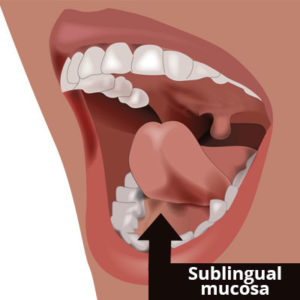How Do Allergy Drops Work?
Allergy drops work like allergy shots by delivering a slowly increasing dose of physician-prescribed, FDA-approved antigen that over time helps you build a tolerance to the things you are allergic to.
The difference is that the drops are placed under the tongue and affect the immune system through very specialized (dendritic) cells found under the tongue. Research shows these cells are a friendlier, effective, and safe route for long-term allergen tolerance, making it an ideal option for patients who aren’t candidates for shots.
Administering the allergy drops multiple times per day is a key factor effecting treatment outcomes.1 In clinical trials, researchers saw additional immunological changes as the course of treatment progressed2, so while you may feel better in the short-term, the average course of allergy drop treatment is three to five years. It is necessary to follow your doctor’s instructions until they determine treatment is complete in order to change your underlying allergic disease.
Why Under-the-Tongue Drops?
 Sublingual immunotherapy is the regular administration of gradually increasing doses of allergens to the area under the tongue in order to create tolerance to allergens responsible for allergy symptoms.
Sublingual immunotherapy is the regular administration of gradually increasing doses of allergens to the area under the tongue in order to create tolerance to allergens responsible for allergy symptoms.
The area under the tongue is referred to as the sublingual mucosa. This “privileged" area has special properties including the highest concentration of dendritic cells in the human body. The dendritic cell is the most powerful antigen/allergen presenting cell because it exposes allergens to T cells which can either induce tolerance or an allergic state. Manipulation of this cell is critical in the practice of immunotherapy as well as any other attempt to induce tolerance. The area under the tongue is unusually rich in dendritic cells and naive T cells ready to react.
Studies have shown that upon administration, allergen is retained under the tongue for at least 48 hours. This gives dendritic cells the opportunity to interact locally with naive T cells. Multiple dosing per day, however, is necessary to establish constant, uninterrupted exposure during treatment.
- Bordignon, V. Burastero, S. (2006). Multiple daily administrations of low-dose sublingual immunotherapy in allergic rhinoconjunctivitis. Annals of Allergy, Asthma & Immunology, 97, 158-163.
- Durham, S. (2008). Sublingual immunotherapy: what have we learnt from the "big trials"? Current Opinion in Allergy and Clinical Immunology. December 2008 - Volume 8 - Issue 6 - p 577–584. doi: 10.1097/ACI.0b013e3283196764
